A GARDEN PEST OF HUMANS
Yellowjacket Frenemies
Not all garden pests attack plants. One pest, not of plants, that especially bugs me around this time most years is yellowjackets. Yellowjackets can be worse than irksome; they can be deadly to people allergic to their sting.
Whether deadly or just irksome, yellowjackets are amongst the orneriest of creatures. They are aggressive and, unlike honeybees, don’t have to stop after one sting. Burying its stinger in your arm has no effect on a yellowjacket’s mortality, so it can do it again if it so pleases or go on to seek out other victims.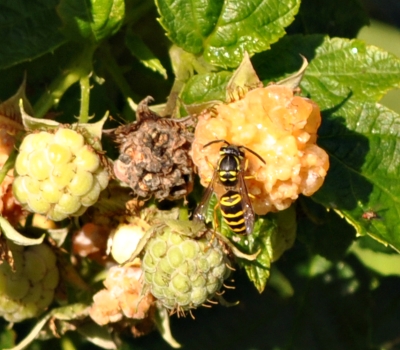
As with all of Mother Nature’s creatures, yellowjackets are not all bad — even from the biased viewpoint of us humans. These aggressive creatures help clean up debris, especially high protein stuff, such as leftover dogfood, earlier in the season, and sweet stuff, such as an unfinished soda, later in the season. Yellowjackets even help out us gardeners, by putting on their menu certain plant pests, such as caterpillars. And even non gardeners by honing in on nuisance flies.
Yellowjackets & Friends
Still, to be honest, I’ll dodge and swat at any yellowjacket that comes near me. One reason is because I’m one of those people who is allergic to their stings, though less so since I received a series of desensitization shots.
Important before swatting is to clearly distinguish between yellowjackets and their friendlier and more beneficial, to us gardeners, kin. Look kindly on fuzzy coated honeybees, generally friendly and valuable for their pollination, as well as on small, darting syrphid flies, also called hover flies, which keep many garden pests in check and don’t sting humans.
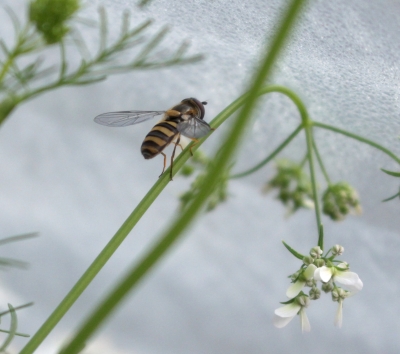
Syrphid fly
Yellowjackets have shiny, yellow and black striped bodies. Two near look-alike close relatives — in the same family, the Vespids — as yellowjackets are paper wasps and bald-faced hornets, neither of which is allegedly quite as aggressive as yellowjackets. (Seems to me that bald-face hornets are the most aggressive, but maybe they just don’t like me.) Paper wasps’ bodies are more slender than those of yellowjackets.
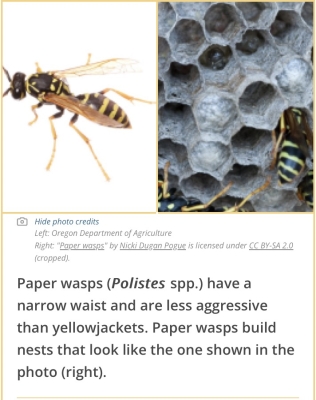
Paper wasp & nest
Bald-faced hornets are black and white, with fearful faces looking like a halloween mask of some evil humanoid.

Ouch! Swatting, even dodging, may be the knee jerk reaction to yellowjackets, but, in fact, is the wrong response. Aggressive or jerky movements incite them to sting. Easier said than done, but most effective at avoiding puncture, is to move slowly and keep calm in their midst. If you wish to appease them further, avoid wearing bright colors or perfumes.
My more rational efforts to thwart yellowjackets begin early each season, when I start patrolling for nests. The whole season’s population begins as a single queen who, after waking from her winter sleep, begins laying eggs. Once she has nursed hatchlings long enough so that they can take over care of the nest, she goes into full scale egg production, building the population.
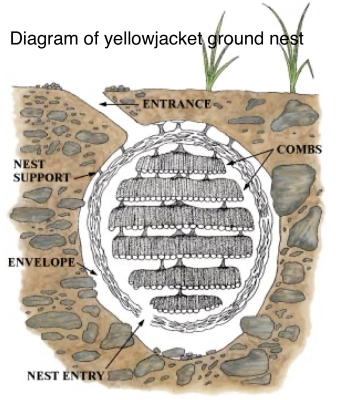
Underground yellowjacket nest
The sooner nests are found and destroyed, the fewer yellowjackets there are buzzing around later in the season. Her Highness typically builds her nest in the ground or in sheltered, warm spots under eaves or against walls. The time to destroy such nests is at night or on cool mornings, when everyone is at home or groggy. A number of products are available to shoot a stream pesticide at such nests from a distance; many effective, low toxicity pesticides have mint oil as their active ingredient.
Trapping can also be effective, especially early in the season when queens are out foraging. Their preferred spring foods are those high in protein, such as meat and dogfood. A home made trap can be as simple as hanging some fish over a pan of soapy water. Later in the season, sweet foods are more to their liking.
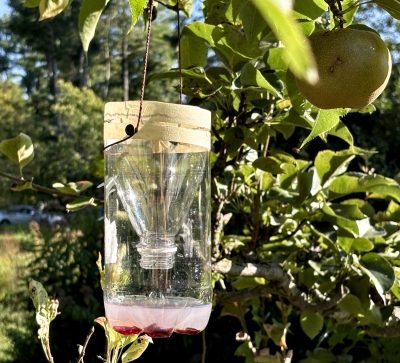
Homemade trap from plastic bottle, sweet bait, and a little soap
Sting Rx
Not attracting yellowjacks is a more effective and desirable way to avoid problems with them. A garden full of ripening grapes, apples, and melons does draw them anyway, but why compound the problem by leaving around dogfood, soda, and other foods rich in proteins or sugars?
Stings happen, whether from the single yellowjacket that wanted you away from its food or from a mass attack from a nest disturbed by your lawnmower or footsteps. It’s ironic that before I got desensitized to their stings, I would be attacked and stung at least once each summer. Since I’ve been more or less desensitized, no stings. Perhaps it’s my newer vibes.
An effective way to lessen the effect of a sting is with a small device called the EXTRACTOR, which is something like a hypodermic syringe in reverse, with a cup on its end instead of a needle. Used quickly, it can suck the venom out of your body before it takes effect. I’ve used it numerous times.
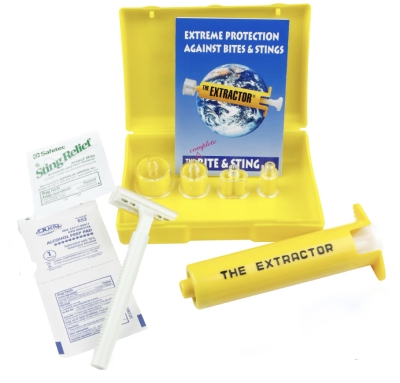
The extractor
Anyone who has experienced a general reaction to such stings, rather than a reaction just at the site of the sting, should also consider carrying an EPIPEN, available with a prescription, and seeking medical attention following a sting.


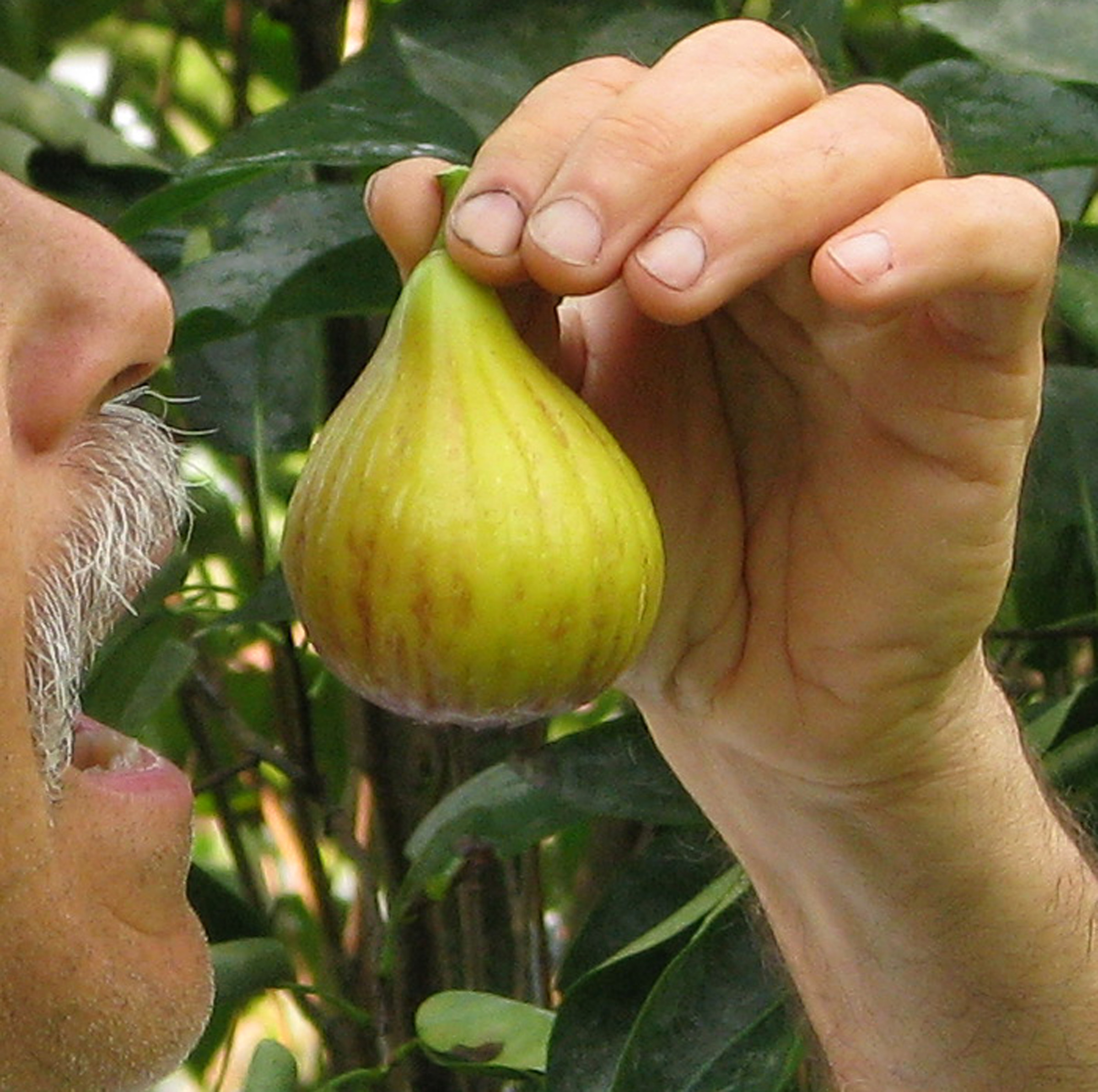

Thank you for information about the Extractor. I’m going to order one. I stepped on an underground nest last week and got stung twice, a first for me. I didn’t experience respiratory problems but had some other strong side effects. In retrospect, I probably should have gone to the ER. I’m seeing my GP soon and will ask if an Epi-pen is a good idea.
Good.
On the other hand, yellow jackets perform important sanitation functions in a garden where they consume overripe and rotting fruits which cuts down on pests and disease like fruit flies and fungal infections. One year I was away for the weekend and couldn’t harvest my raspberries daily as was my custom. I was worried about finding rotting raspberries when I returned, but to my delight in my absence the yellow jackets had sucked the juice out of all the over-the-hill raspberries
True ‘nough.